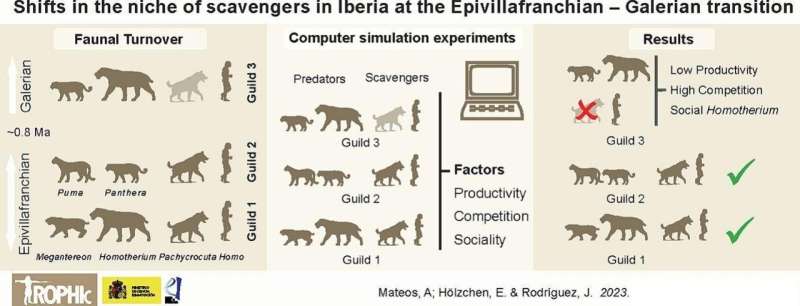This article has been reviewed according to Science X's editorial process and policies. Editors have highlighted the following attributes while ensuring the content's credibility:
fact-checked
peer-reviewed publication
proofread
Turnover in the Iberian fauna reduced the availability of carrion one million years ago: Study

Ana Mateos and Jesús Rodríguez, scientists at the Centro Nacional de Investigación sobre la Evolución Humana (CENIEH), have published a paper in the journal Palaeogeography, Palaeoclimatology, Palaeoecology showing that large herbivore carrion, a resource that had formerly been abundant and accessible to hominins, became scarcer at the end of the Early Pleistocene due to changes in the Iberian fauna.
Hominins arrived in the Iberian Peninsula about 1.4 million years ago, where they found a wide variety of food resources including a great abundance of carcasses of large herbivores partially consumed by a diversity of predators, important among which were two species of saber-tooth cats (Homotherium latidens and Megantereon whitei).
They also encountered a powerful competitor in these ecosystems, the giant hyena (Pachycrocuta brevirostris). However, as the same authors showed in earlier work, the wealth of food and diversity of the ecosystems at this period made the coexistence of hominins and giant hyenas competing for carrion possible.
That being said, about 1 million years ago there were major climatic changes that restructured the ecosystems of the whole of Europe. In the Iberian Peninsula, the large mammal fauna suffered the extinction of several species, including the giant hyena and one of the saber-tooth cats (M. whitei), leading to lower availability of carrion.
Virtual simulations
The researchers employed a computational model that enables experiments in a virtual environment that simulate the behavior of hyenas and hominins competing for carrion. Each experiment represents a different ecological scenario, defined by the predator species present, the productivity of the ecosystem, and the competition for carrion with other species like vultures or small carnivores.
"The giant hyenas and hominins could coexist in competition for carrion prior to the extinction of the saber-tooth Megantereon and other predators, like the lycaons (canids) and pumas. However, after those predators disappeared carrion became scantier. This coincides with the extinction of the giant hyena," explains Mateos.
According to the results of these experiments, among the key factors that determined these changes were the low productivity of the ecosystems during the very cold intervals of the period, strong competition with scavengers other than the giant hyena, and the likely social behavior of the other great saber-tooth (H. latidens).
Unlike hyenas, which would have depended exclusively on large herbivore carcasses for food, hominin behavior would have been much more flexible as they could also exploit plant resources like fruit, berries or roots, hunt small animals and even kill larger ones.
"This greater flexibility in procuring food would have allowed them to survive and adapt to the new prevailing ecological conditions following the changes in the climate and fauna 1 million years ago," adds Rodríguez.
More information: Ana Mateos et al, Sabretooths, giant hyenas, and hominins: Shifts in the niche of Early Pleistocene scavengers in Iberia at the Epivillafranchian-Galerian transition, Palaeogeography, Palaeoclimatology, Palaeoecology (2023). DOI: 10.1016/j.palaeo.2023.111926
Journal information: Palaeogeography, Palaeoclimatology, Palaeoecology
Provided by CENIEH




















